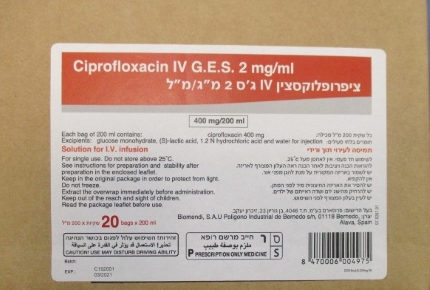Quest for the right Drug

ציפרופלוקסצין I.V אלטן2 מ"ג/מ"ל CIPROFLOXACIN I.V ALTAN 2 MG/ML (CIPROFLOXACIN)
תרופה במרשם
תרופה בסל
נרקוטיקה
ציטוטוקסיקה
צורת מתן:
תוך-ורידי : I.V
צורת מינון:
תמיסה לאינפוזיה : SOLUTION FOR INFUSION
עלון לרופא
מינוניםPosology התוויות
Indications תופעות לוואי
Adverse reactions התוויות נגד
Contraindications אינטראקציות
Interactions מינון יתר
Overdose הריון/הנקה
Pregnancy & Lactation אוכלוסיות מיוחדות
Special populations תכונות פרמקולוגיות
Pharmacological properties מידע רוקחי
Pharmaceutical particulars אזהרת שימוש
Special Warning עלון לרופא
Physicians Leaflet
Adverse reactions : תופעות לוואי
4.8. Undesirable effects The most commonly reported adverse drug reactions (ADRs) are nausea, diarrhoea, vomiting, transient increase in transaminases, rash, and injection and infusion site reactions. ADRs derived from clinical studies and post-marketing surveillance with ciprofloxacin (oral, intravenous and sequential therapy) sorted by categories of frequency are listed below. The frequency analysis takes into account data from both oral and intravenous administration of ciprofloxacin. System organ Common Uncommon Rare ≥1/10,000 to Very rare Frequency class ≥1/100 to <1/10 ≥1/1 000 to <1/1,000 <1/10,000 unknown <1/100 (cannot be estimated from the available data) Infections and Mycotic Antibiotic associated infestations superinfections colitis (very rarely with possible fatal outcome) (see section 4.4) Blood and Eosinophilia Leukopenia, Haemolytic lymphatic Anaemia, anaemia, system Neutropenia, Agranulocytosis, disorders Leukocytosis, Pancytopenia Thrombocytopenia, (life- Thrombocytemia threatening), Bone marrow depression (life- threatening) Immune system Allergic reaction, Anaphylactic disorders Allergic oedema / reaction, Angio-oedema Anaphylactic shock (life- threatening), (see section 4.4) Serum sickness-like reaction Endocrine Syndrome of disorders inappropriate secretion of antidiuretic hormone (SIADH) Metabolism and Anorexia, Hyperglycaemia, Hypoglycaemic nutrition Decreased Hypoglycaemia (see coma (see disorders appetite section 4.4) section 4.4) Psychiatric Psychomotor Confusion and Psychotic Mania, incl. disorders (*) hyperactivity / disorientation, reactions hypomania agitation Anxiety reaction, (potentially Abnormal dreams culminating in Depression suicidal (potentially ideations/ culminating in thoughts or suicidal suicide ideations/thoughts attempts and or suicide attempts completed and completed suicide) (see suicide) (see section 4.4) section 4.4), Hallucinations Nervous system Headache, Par- and Migraine, Peripheral disorders (*) Dizziness, Dysaesthesia, Disturbed neuropathy Sleep Hypoaesthesia, coordination, and disorders, Tremor, Seizures Gait disturbance, polyneuropathy Taste disorders (including status Olfactory nerve (see section epilepticus, see disorders, 4.4) section 4.4), Intracranial Vertigo hypertension and pseudotumor cerebri Eye disorders (*) Visual Visual colour disturbances distortions (e.g.diplopia) Ear and labyrinth Tinnitus, disorders (*) Hearing loss / hearing impaired Cardiac disorders Tachycardia Ventricular (**) arrhythmia and torsades de pointes (reported predominantly in patients with risk factors for QT prolongation), ECG QT prolonged (see section 4.4 and 4.9). Vascular Vasodilation, Vasculitis disorders (**) Hypotension, Syncope Respiratory, Dyspnoea thoracic and (including asthmatic mediastinal condition) disorders Gastrointestinal Nausea, Vomiting, Antibiotic-associated Pancreatitis disorders Diarrhoea Gastrointestinal colitis (very rarely and abdominal with possible fatal pain, outcome) (see Dyspepsia, section 4.4) Flatulence Hepato-biliary Increase in Hepatic Liver necrosis disorders transaminases, impairment, (very rarely Increased Cholestatic icterus, progressing to bilirubin Hepatitis life-threatening hepatic failure) (see section 4.4) Skin and Rash, Photosensitivity Petechiae, Acute subcutaneous Pruritus, reactions (see Erythema Generalised tissue disorders Urticaria section 4.4) multiforme, Exanthematous Erythema Pustulosis nodosum, (AGEP) Stevens- Drug Reaction Johnson with syndrome Eosinophilia and (potentially life- Systemic threatening), Toxic epidermal Symptoms necrolysis (DRESS) (potentially life- threatening) Musculoskeletal Musculoskeletal Myalgia Muscular and connective pain (e.g. Arthritis weakness tissue disorders extremity pain, Increased muscle Tendinitis back pain and tone and cramping Tendon ruptures chest pain), (predominantly Arthralgia Achilles tendon) (see section 4.4), Exacerbation of symptoms of myasthenia gravis (see section 4.4) Renal and Renal Renal failure, urinary impairment Haematuria, disorders Crystalluria (see section 4.4), Tubulointerstitial nephritis General Injection and Asthenia, Oedema, disorders and infusion site Fever Sweating administration reactions (hyperhidrosis) site (only conditions (*) intravenous Investigations administration) Increase in Prothrombin level International blood alkaline abnormal, increased normalised phosphatase amylase ratio increased (in patients treated with Vitamin K antagonists) *Very rare cases of prolonged (up to months or years), disabling and potentially irreversible serious drug reactions affecting several, sometimes multiple, system organ classes and senses (including reactions such as tendonitis, tendon rupture, arthralgia, pain in extremities, gait disturbance, neuropathies associated with paraesthesia, depression, fatigue, memory impairment, sleep disorders, and impairment of hearing, vision, taste and smell) have been reported in association with the use of quinolones and fluoroquinolones in some cases irrespective of preexisting risk factors (see section 4.4). **Cases of aortic aneurysm and dissection, sometimes complicated by rupture (including fatal ones), and of regurgitation/incompetence of any of the heart valves have been reported in patients receiving fluoroquinolones (see section 4.4). The following undesirable effects have a higher frequency category in the subgroups of patients receiving intravenous or sequential (intravenous to oral) treatment: Common Vomiting, transient increase in transaminases, rash Uncommon Thrombocytopenia, thrombocytaemia, confusion and disorientation, hallucinations, par- and dysaesthesia, seizures, vertigo, visual disturbances, hearing loss, tachycardia, vasodilatation, hypotension, transient hepatic impairment, cholestatic icterus, renal failure, oedema Rare Pancytopenia, bone marrow depression, anaphylactic shock, psychotic reactions, migraine, olfactory nerve disorders, hearing impaired, vasculitis, pancreatitis, liver necrosis, petechiae, tendon rupture Paediatric population The incidence of arthropathy (arthralgia, arthritis), mentioned above, is referring to data collected in studies with adults. In children, arthropathy is reported to occur commonly (see section 4.4). Reporting of suspected adverse reactions Reporting suspected adverse reactions after authorisation of the medicinal product is important. It allows continued monitoring of the benefit/risk balance of the medicinal product. Any suspected adverse events should be reported to the Ministry of Health according to the National Regulation by using an online form: https://sideeffects.health.gov.il

שימוש לפי פנקס קופ''ח כללית 1994
לא צוין
תאריך הכללה מקורי בסל
לא צוין
הגבלות
לא צוין
מידע נוסף
